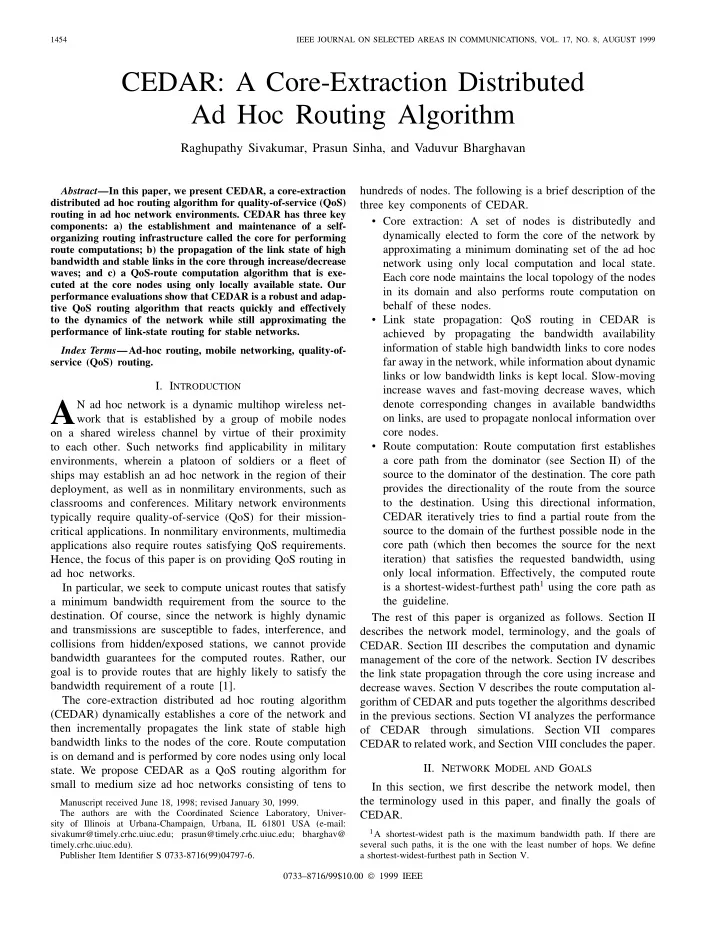

1454 IEEE JOURNAL ON SELECTED AREAS IN COMMUNICATIONS, VOL. 17, NO. 8, AUGUST 1999 CEDAR: A Core-Extraction Distributed Ad Hoc Routing Algorithm Raghupathy Sivakumar, Prasun Sinha, and Vaduvur Bharghavan hundreds of nodes. The following is a brief description of the Abstract— In this paper, we present CEDAR, a core-extraction distributed ad hoc routing algorithm for quality-of-service (QoS) three key components of CEDAR. routing in ad hoc network environments. CEDAR has three key • Core extraction: A set of nodes is distributedly and components: a) the establishment and maintenance of a self- dynamically elected to form the core of the network by organizing routing infrastructure called the core for performing approximating a minimum dominating set of the ad hoc route computations; b) the propagation of the link state of high bandwidth and stable links in the core through increase/decrease network using only local computation and local state. waves; and c) a QoS-route computation algorithm that is exe- Each core node maintains the local topology of the nodes cuted at the core nodes using only locally available state. Our in its domain and also performs route computation on performance evaluations show that CEDAR is a robust and adap- behalf of these nodes. tive QoS routing algorithm that reacts quickly and effectively • Link state propagation: QoS routing in CEDAR is to the dynamics of the network while still approximating the performance of link-state routing for stable networks. achieved by propagating the bandwidth availability information of stable high bandwidth links to core nodes Index Terms— Ad-hoc routing, mobile networking, quality-of- far away in the network, while information about dynamic service (QoS) routing. links or low bandwidth links is kept local. Slow-moving I. I NTRODUCTION increase waves and fast-moving decrease waves, which A N ad hoc network is a dynamic multihop wireless net- denote corresponding changes in available bandwidths work that is established by a group of mobile nodes on links, are used to propagate nonlocal information over on a shared wireless channel by virtue of their proximity core nodes. to each other. Such networks find applicability in military • Route computation: Route computation first establishes environments, wherein a platoon of soldiers or a fleet of a core path from the dominator (see Section II) of the ships may establish an ad hoc network in the region of their source to the dominator of the destination. The core path deployment, as well as in nonmilitary environments, such as provides the directionality of the route from the source to the destination. Using this directional information, classrooms and conferences. Military network environments CEDAR iteratively tries to find a partial route from the typically require quality-of-service (QoS) for their mission- source to the domain of the furthest possible node in the critical applications. In nonmilitary environments, multimedia core path (which then becomes the source for the next applications also require routes satisfying QoS requirements. iteration) that satisfies the requested bandwidth, using Hence, the focus of this paper is on providing QoS routing in only local information. Effectively, the computed route ad hoc networks. is a shortest-widest-furthest path 1 using the core path as In particular, we seek to compute unicast routes that satisfy the guideline. a minimum bandwidth requirement from the source to the destination. Of course, since the network is highly dynamic The rest of this paper is organized as follows. Section II and transmissions are susceptible to fades, interference, and describes the network model, terminology, and the goals of collisions from hidden/exposed stations, we cannot provide CEDAR. Section III describes the computation and dynamic bandwidth guarantees for the computed routes. Rather, our management of the core of the network. Section IV describes goal is to provide routes that are highly likely to satisfy the the link state propagation through the core using increase and bandwidth requirement of a route [1]. decrease waves. Section V describes the route computation al- The core-extraction distributed ad hoc routing algorithm gorithm of CEDAR and puts together the algorithms described (CEDAR) dynamically establishes a core of the network and in the previous sections. Section VI analyzes the performance then incrementally propagates the link state of stable high of CEDAR through simulations. Section VII compares bandwidth links to the nodes of the core. Route computation CEDAR to related work, and Section VIII concludes the paper. is on demand and is performed by core nodes using only local II. N ETWORK M ODEL AND G OALS state. We propose CEDAR as a QoS routing algorithm for small to medium size ad hoc networks consisting of tens to In this section, we first describe the network model, then the terminology used in this paper, and finally the goals of Manuscript received June 18, 1998; revised January 30, 1999. The authors are with the Coordinated Science Laboratory, Univer- CEDAR. sity of Illinois at Urbana-Champaign, Urbana, IL 61801 USA (e-mail: 1 A shortest-widest path is the maximum bandwidth path. If there are sivakumr@timely.crhc.uiuc.edu; prasun@timely.crhc.uiuc.edu; bharghav@ timely.crhc.uiuc.edu). several such paths, it is the one with the least number of hops. We define Publisher Item Identifier S 0733-8716(99)04797-6. a shortest-widest-furthest path in Section V. 0733–8716/99$10.00 1999 IEEE
Recommend
More recommend